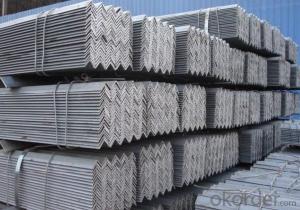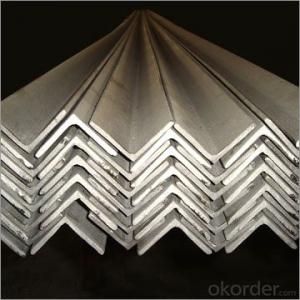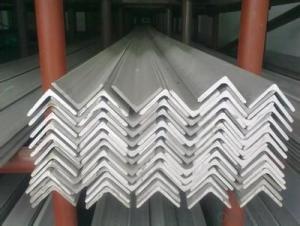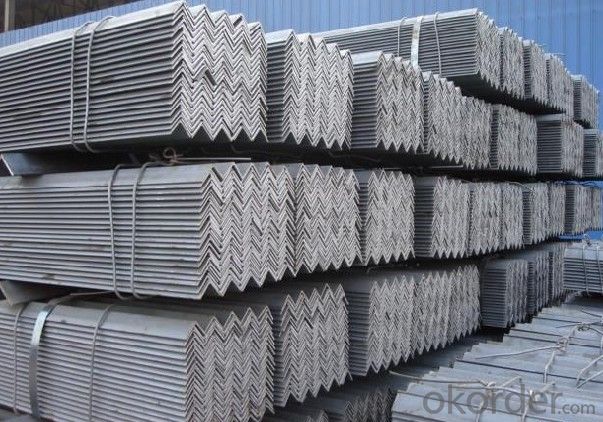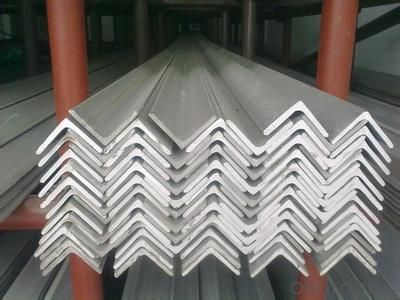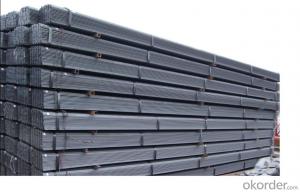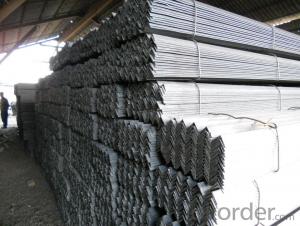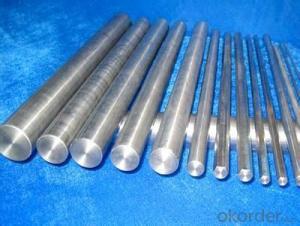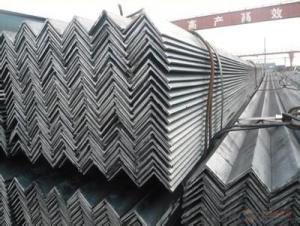Unequal Steel Hot Rolled High Quality GB Q235 or Q345
- Loading Port:
- Shanghai
- Payment Terms:
- TT OR LC
- Min Order Qty:
- 25 m.t.
- Supply Capability:
- 20000000 m.t./month
OKorder Service Pledge
OKorder Financial Service
You Might Also Like
Product Description:
OKorder is offering Unequal Steel Hot Rolled High Quality GB Q235 or Q345 at great prices with worldwide shipping. Our supplier is a world-class manufacturer of steel, with our products utilized the world over. OKorder annually supplies products to European, North American and Asian markets. We provide quotations within 24 hours of receiving an inquiry and guarantee competitive prices.
Product Applications:
According to the needs of different structures, Angle can compose to different force support component, and also can be the connections between components. It is widely used in various building structures and engineering structures such as roof beams, bridges, transmission towers, hoisting machinery and transport machinery, ships, industrial furnaces, reaction tower, container frame and warehouse etc
Product Advantages:
OKorder's Unequal Steel Hot Rolled High Quality GB Q235 or Q345 are durable, strong, and resist corrosion.
Main Product Features:
· Premium quality
· Prompt delivery & seaworthy packing (30 days after receiving deposit)
· Corrosion resistance
· Can be recycled and reused
· Mill test certification
· Professional Service
· Competitive pricing
Product Specifications:
Manufacture: Hot rolled
Grade: Q195 – 235
Certificates: ISO, SGS, BV, CIQ
Length: 6m – 12m, as per customer request
Packaging: Export packing, nude packing, bundled
Sizes: 25mm-250mm | ||||||||||
a*t | ||||||||||
25*2.5-4.0 | 70*6.0-9.0 | 130*9.0-15 | ||||||||
30*2.5-6.6 | 75*6.0-9.0 | 140*10-14 | ||||||||
36*3.0-5.0 | 80*5.0-10 | 150*10-20 | ||||||||
38*2.3-6.0 | 90*7.0-10 | 160*10-16 | ||||||||
40*3.0-5.0 | 100*6.0-12 | 175*12-15 | ||||||||
45*4.0-6.0 | 110*8.0-10 | 180*12-18 | ||||||||
50*4.0-6.0 | 120*6.0-15 | 200*14-25 | ||||||||
60*4.0-8.0 | 125*8.0-14 | 250*25 | ||||||||
FAQ:
Q3: How soon can we receive the product after purchase?
A3: Within three days of placing an order, we will begin production. The specific shipping date is dependent upon international and government factors, but is typically 7 to 10 workdays.
Q4: What makes stainless steel stainless?
A4: Stainless steel must contain at least 10.5 % chromium. It is this element that reacts with the oxygen in the air to form a complex chrome-oxide surface layer that is invisible but strong enough to prevent further oxygen from "staining" (rusting) the surface. Higher levels of chromium and the addition of other alloying elements such as nickel and molybdenum enhance this surface layer and improve the corrosion resistance of the stainless material.
Q5: Can stainless steel rust?
A5: Stainless does not "rust" as you think of regular steel rusting with a red oxide on the surface that flakes off. If you see red rust it is probably due to some iron particles that have contaminated the surface of the stainless steel.

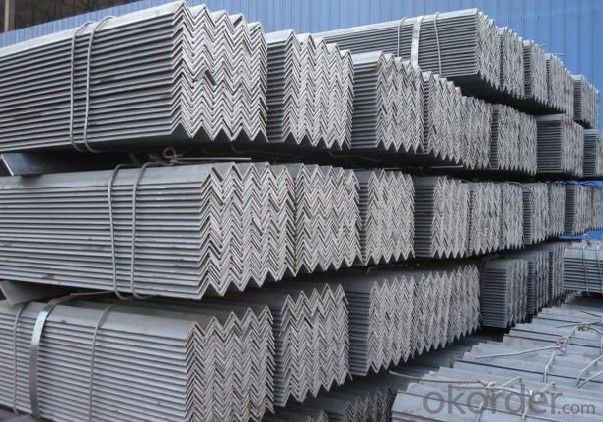
- Q: Can steel angles be used for framing or supporting exterior cladding systems?
- Yes, steel angles can be used for framing or supporting exterior cladding systems. Steel angles provide structural support and stability, making them suitable for this purpose. They can be used to create a framework or support structure for exterior cladding systems, ensuring durability and architectural integrity.
- Q: What are the standard sizes of steel angles?
- The standard sizes of steel angles can vary depending on the region and industry, but there are some common sizes that are widely used. In general, steel angles come in equal leg and unequal leg sizes. For equal leg angles, the standard sizes range from 20x20mm to 200x200mm, with thicknesses ranging from 3mm to 26mm. Unequal leg angles typically have one leg longer than the other, and their standard sizes range from 25x16mm to 200x150mm, with thicknesses ranging from 3mm to 15mm. These standard sizes are commonly used in construction, engineering, and manufacturing industries for various applications, such as structural supports, framing, and bracing. It's important to note that these sizes may vary depending on the specific requirements of a project or the standards set by the governing bodies within the industry.
- Q: Can steel angles be used for mezzanines or catwalks?
- Yes, steel angles can be used for mezzanines or catwalks. Steel angles are often used as structural supports in construction projects due to their strength and versatility. They can provide the necessary stability and load-bearing capacity required for mezzanines and catwalks, making them a suitable choice for such applications.
- Q: How do steel angles contribute to the overall aesthetics of a structure?
- Steel angles can contribute to the overall aesthetics of a structure in multiple ways. Firstly, steel angles can be used as decorative elements to create interesting and visually appealing designs. They can be incorporated into the architectural design to add unique and distinctive features to the structure. For example, steel angles can be used to create patterns, shapes, or even sculptures that enhance the overall aesthetic appeal of the building. Additionally, steel angles can be used to create a sense of balance and symmetry in the structure. By strategically placing steel angles at specific locations, architects can create a visually pleasing and harmonious design. The use of steel angles can help to break up large, monotonous surfaces and add depth and dimension to the structure, making it more visually interesting. Furthermore, steel angles can contribute to the aesthetic appeal of a structure by providing a sleek and modern appearance. The clean lines and sharp edges of steel angles can give a contemporary and industrial look to the building, which is often desired in modern architecture. The use of steel angles can also convey a sense of strength and stability, which can be visually appealing and reassuring to observers. Lastly, steel angles can be utilized to enhance the overall structural integrity of the building. While aesthetics are important, it is also crucial to ensure the safety and stability of the structure. Steel angles can be strategically placed to provide additional support and reinforcement, ensuring that the building is not only visually appealing but also structurally sound. In conclusion, steel angles can contribute to the overall aesthetics of a structure by adding decorative elements, creating balance and symmetry, providing a sleek and modern appearance, and enhancing the structural integrity. By incorporating steel angles into the design, architects can create visually stunning buildings that are both aesthetically pleasing and structurally sound.
- Q: How do you calculate the bending stress in a steel angle?
- To calculate the bending stress in a steel angle, you need to understand the basics of bending moment and the moment of inertia of the angle. First, you will need to determine the bending moment acting on the steel angle. This can be done by considering the applied load or force and its distance from the point of rotation. The bending moment is calculated as the product of the applied load and the distance between the point of rotation and the line of action of the force. Next, you will need to determine the moment of inertia of the steel angle. The moment of inertia measures the resistance of an object to changes in its rotational motion. It depends on the shape and size of the object. In the case of a steel angle, the moment of inertia can be calculated using the appropriate formula for the specific cross-sectional shape of the angle. Once you have determined the bending moment and the moment of inertia, you can calculate the bending stress using the formula: Bending Stress = (Bending Moment * Distance from Neutral Axis) / Moment of Inertia The bending stress represents the internal resistance within the steel angle to the bending moment. It is typically expressed in units of force per unit area, such as pounds per square inch (psi) or newtons per square meter (Pa). It is important to note that the calculation of bending stress assumes that the steel angle behaves elastically, meaning it is not subjected to excessive deformation or permanent damage. If the applied bending moment exceeds the elastic limit of the steel angle, plastic deformation or failure may occur, and a different analysis method would be required.
- Q: How do you determine the load capacity of a steel angle?
- The load capacity of a steel angle is determined by calculating its moment of inertia and considering factors such as material strength, dimensions, and the type of loading it will be subjected to. Additionally, engineering standards and codes provide guidelines for determining load capacities based on these calculations.
- Q: What are the maintenance requirements for steel angles?
- The maintenance requirements for steel angles can vary depending on the specific environment and conditions they are exposed to. However, there are some general guidelines to follow to ensure their longevity and functionality. Firstly, it is important to regularly inspect steel angles for any signs of damage or corrosion. This can be done by visually examining the angles and checking for any discoloration, rust, or surface irregularities. If any issues are detected, they should be addressed promptly to prevent further deterioration. Cleaning the steel angles on a regular basis is also essential. This can be done by using a mild detergent or soap solution and a soft cloth or sponge. Avoid using abrasive cleaners or tools that can scratch the surface of the angles. After cleaning, it is important to thoroughly rinse the angles with clean water and dry them completely to prevent moisture buildup. To protect steel angles from corrosion, applying a protective coating or paint is recommended. This can act as a barrier against moisture and other corrosive elements. It is important to choose a coating or paint that is specifically designed for steel and suitable for the intended environment. Regular inspection and touch-up of the coating or paint may be necessary to maintain its effectiveness. Additionally, it is crucial to prevent prolonged exposure to harsh chemicals or corrosive substances that can damage the steel angles. If the angles are installed in an environment where they may come into contact with such substances, it is important to provide appropriate protective measures, such as using chemical-resistant coatings or barriers. Finally, it is advisable to follow any specific maintenance recommendations provided by the manufacturer or supplier of the steel angles. They may have additional guidelines or requirements based on the specific type or grade of steel used. By following these maintenance requirements, steel angles can remain in good condition, retain their structural integrity, and provide long-lasting performance.
- Q: Can steel angles be drilled or machined?
- Drilling or machining steel angles is indeed possible. Their strength and durability make them popular in the construction and manufacturing sectors. Creating holes or shaping them to specific sizes is easily achievable through drilling or machining. However, it is crucial to employ suitable tools and techniques due to their tough composition, necessitating the use of high-speed drilling or machining equipment. Moreover, employing lubricants or coolant during the process can minimize friction and heat accumulation, resulting in a seamless and efficient operation.
- Q: How do steel angles perform under high temperatures?
- Steel angles perform well under high temperatures as they have a high melting point and exhibit good thermal conductivity. They retain their strength and structural integrity, making them suitable for use in various applications such as construction, manufacturing, and industrial processes that involve elevated temperatures.
- Q: What is the minimum bend radius for a steel angle?
- The minimum bend radius for a steel angle depends on the specific dimensions and thickness of the angle. It is generally recommended to consult the manufacturer or reference industry standards to determine the appropriate minimum bend radius for a particular steel angle.
Send your message to us
Unequal Steel Hot Rolled High Quality GB Q235 or Q345
- Loading Port:
- Shanghai
- Payment Terms:
- TT OR LC
- Min Order Qty:
- 25 m.t.
- Supply Capability:
- 20000000 m.t./month
OKorder Service Pledge
OKorder Financial Service
Similar products
Hot products
Hot Searches
Related keywords
